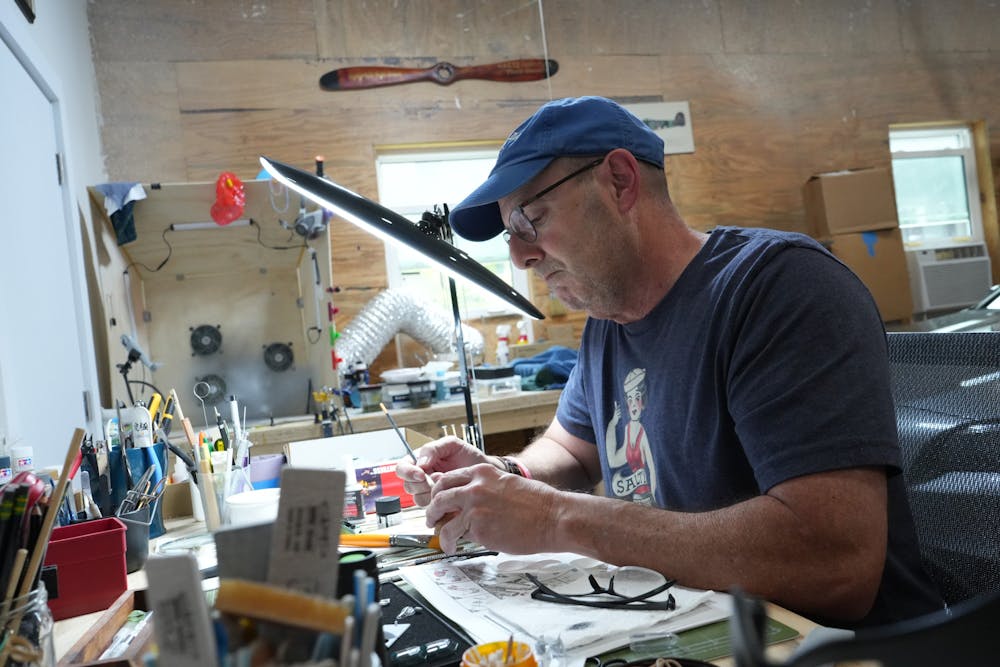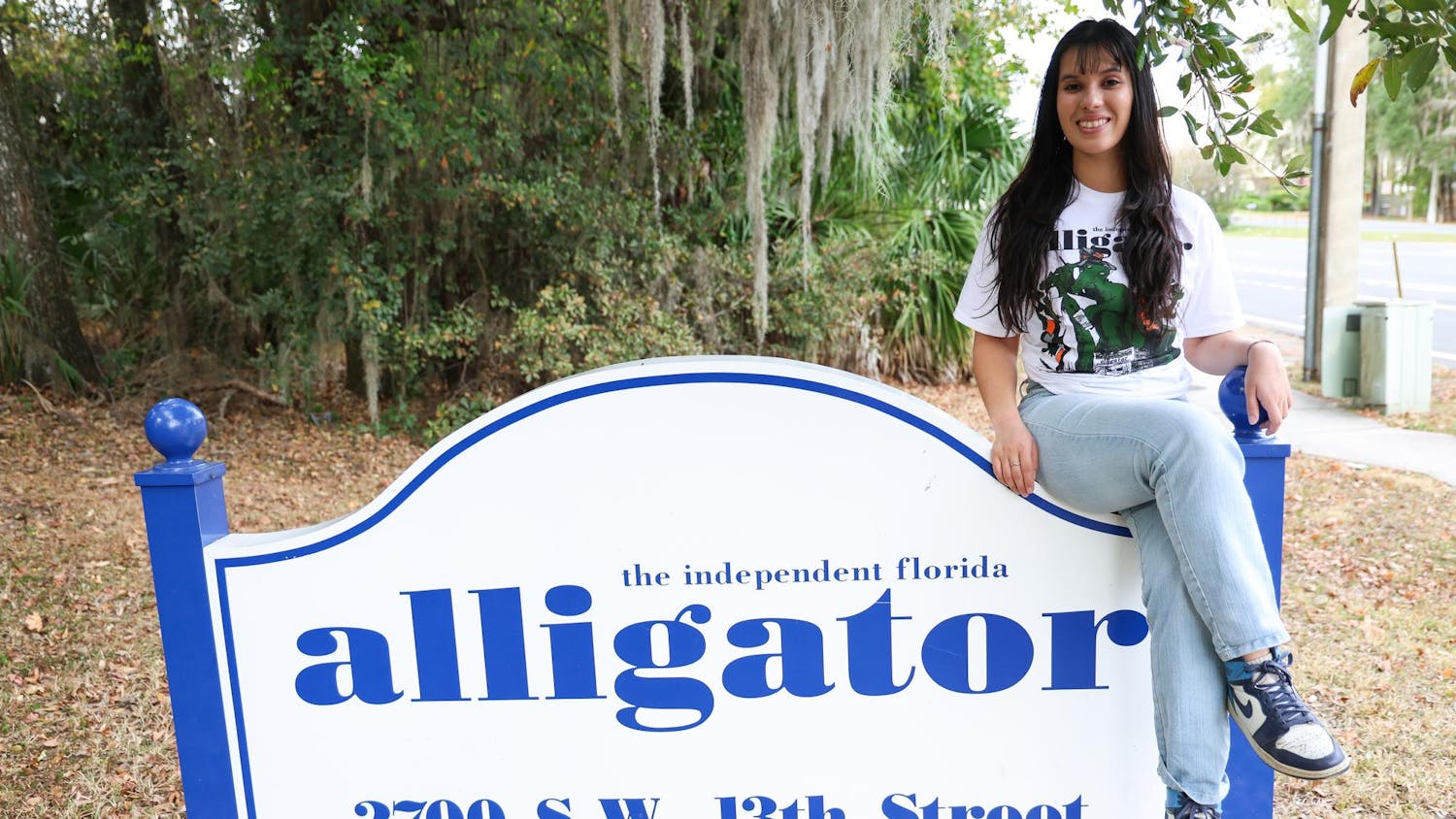Editor’s note: Based on mission descriptions in the “Eyes of the Eighth” by Patricia Fussell Keen and additional research, this is the most likely series of events.
Sitting on the runway of Mount Farm airfield in Oxfordshire County in England, in the sweaty cockpit of an F-5 Lightning, Lt. Edward Durst was getting ready to take off on his first operational mission with the 7th Photo Reconnaissance Group.
Durst, who was 21 at the time, was one of four airmen on the mission. He was the newest member of the group and had something to prove.
Flying “The Florida Gator” — a blue plane with bright orange trim, and a large alligator mouth with orange lips — Durst approached the French coast at 24,000 feet as the third plane in the formation with nothing but speed and a camera.
“The Florida Gator” flew a total of six people during its lifetime. Monday marks the 79th anniversary of Edward Durst’s death on the Florida Gator’s final mission.
In order to liberate Europe following D-Day on June 6, 1944, Allied troops needed to breakout and move east through France. And they needed to occupy Saint-Lô — a city in northwestern France — to do it.
Chris Brassfield, 56, from Winchester, Kentucky, is the historian for the 466th Bomb Group, which also flew out of England. He has a lifelong interest in World War II aviation, and he works as a remote volunteer to the American Air Museum’s database in Britain.
“The American army and British Army needed to break out,” Brassfield said. “A large number of bombers and the army had kind of gathered up and they just bombed the hell out of Saint-Lô.”
The F-5 Lightning is a derivative of the P-38 Lightning Fighter, which only has one gun in its nose section. In the F-5, those guns were replaced with cameras, Brassfield said.
“They relied on speed and being able to run away from the enemy plane or get up high as their only defense,” Brassfield said.
The group's mission was to photograph areas heavily bombed by Allied Forces and areas still needed to be hit so ground troops could advance.
“Eyes of the Eighth,” written by Patricia Keen, is a book about the 7th Photographic Reconnaissance Group. At 378 pages, it includes extensive descriptions of various missions and stories of the men who belonged to the group.
“The four pilots crossed the Channel and flew down along the western side of the Cherbourg Peninsula,” Keen wrote. “As they flew over Guernsey in the Channel Islands, the German anti-aircraft batteries fired heavy flak accurate for altitude but about 200 yards behind. No one was hit.”
All four men escaped the attack unscathed, yet Durst fell behind, unresponsive to radio calls.
Durst and “The Florida Gator,” a plane borrowed from former UF student Waldo C. Bruns, did not make it back to Mount Farm.
While all four aircrafts made it past the heavy flak, an anti-aircraft projectile which exploded at altitude, and sent metal fragments into its target. It’s believed that Durst’s oxygen line was cut in the barrage, according to Keen. The next few moments were intense for the three men flying with Durst, as the oxygen to his brain was slowly cut off.
As they neared the Saint-Malo area, Durst made a wide sweep, nearly colliding with Lt. Harold G. Wier, flying the left wing position, second in the formation.
Wier and Lt. Alexander Kann, who was flying directly behind Durst in the rear position, saw him dive 15,000 feet. Mission leader Lt. James B. Matthews saw him dive another 12,000.
Durst crashed and burned next to a hangar on the edge of Ploubalay airfield near Plombieres, France. It was later declared that he most likely died of hypoxia, a medical episode that occurs when there’s not sufficient oxygen reaching the brain.
The Germans prevented anyone from immediately going near the crash but eventually local firewomen were allowed to approach. One woman brought a sheet to bury what remained of Durst. Nothing but ash remained of “The Florida Gator,” and the three other men on the mission returned to Mount Farm without Durst.
The Germans entrusted Durst to the Town Hall on the request of Mayor Roussel, and his funeral was held two days later on July 26, 1944.
“Witnesses recall these moments of emotion, a huge crowd flock to the Church, an abundance of flowers covered the forecourt of each side,” according to the American Air Museum in Britain.
Documents at the American War Memorials Overseas reveal Germans also paid their respects. Soon after Durst’s death, his sick mother, Ella Magee, joined him. His body was returned to the U.S. on July 18, 1948, and he was buried at Elmwood Cemetery in Texas.
More than 2,000 bombs were dropped between July 24 and July 25 of 1944, and 136 American soldiers were killed by misfired bombs. Historian Rick Atkinson, author of “Guns at Last Light,” said of the devastation that, “Hardly a trace of sidewalk or street pavement remained in Saint-Lô.”
Overtaking Saint-Lô was instrumental in expelling German forces from Northern France. Brassfield’s grandfather stood outside of Saint-Lô as American bombers dropped bomb after bomb, he said.
“I can remember him telling me about standing outside of Saint-Lô and watching the bombers come across all day long, pounding the place,” Brassfield said. “And then he drove through the next day with his battalion, and he said the place was destroyed. That's the first time he ever saw dead bodies up close.”
While Durst’s tale had a tragic end, his story didn’t die in a town in France, and neither did “The Florida Gator.”
Sam Harris, former special operations helicopter pilot in the United States Navy, 1986 UF journalism graduate and Embry–Riddle Aeronautical University professor, stumbled upon the history of “The Florida Gator” by accident. It piqued his interest because of his background in aviation, and around the time he discovered the plane, his son Kyle had been accepted to UF.
The plane was a bit of a shock to Harris. With bright orange lips and orange trim around the wheel, Harris thought the picture of the plane was distorted.
“These old airplanes, when you see them, they usually have a scantily clad woman on there,” Harris said. “And some zippy saying ‘bombs away’ or something like that.”
Harris had never seen a plane named after a college or university, he said. There was no Crimson Tide or University of Michigan plane he could ever recall seeing. He decided to look a little deeper.
Harris completed two tours in Iraq during his 10 years on active duty. He retired from the Navy Reserves after 20 years in 2016. With so much free time on his hands, he decided he would build a model of the plane for his baby Gator — his son Kyle. After all, UF is his alma mater.
“I had all this time on my hands, and for therapeutic purposes – if nothing else, just good therapy – I said, ‘I'm gonna build this model and give it to my kid,’” Harris said.
In his quest for more information, Harris discovered a story that kept on giving.
Typically, the pilot of a plane or the crew chief, the person who takes care of the plane, gets to name it. Durst was from Texas, so Harris ruled him out, he said.
The crew chief, Johnny Ginex, was from Florida, but when Harris tracked down his niece, former UF student Denis Ginex, in Tampa, she informed Harris that her great uncle had an eighth grade education and couldn’t imagine him being a big Florida fan, Harris said.
Then, Harris found the true pilot of the Florida Gator.
“The pilot was from Florida – Levy County – and that is Waldo Bruns,” Harris said.
Bruns was a UF student prior to enlisting in the service in 1940. However, there are no records of Brun’s attendance at UF, UF registrar told Harris.
Bruns lived in Levy County, but the Levy County Historical Society has no marriage records of him, according to Levy County historical society president Toni Collins. The 1948 land records of the county show his parents, Van and Faye Bruns, buying property in Williston, Florida.
Bruns would’ve left UF during his sophomore year to enlist, Harris said. The American Air Museum in Britain records show him enlisting in the U.S. Air Force on Sept. 16, 1940. He was stationed in Mount Farm, England, from Jan. 20, 1940 to his death on Aug. 14, 1944, according to the air museum.
“The Florida Gator” went down months prior to Brun’s final mission, but Durst and Bruns died in similar ways.
Bruns was the operations officer of the 13th Squadron, and on Aug. 14, 1944, he told his squadron commander, Maj. Robert Smith that the weather was good in areas of long-desired targets. The two decided to go after the targets together, but only one would eventually return home.
Their mission goals were to photograph Focke-Wulf, a German aircraft factory in Poland; Stalag Luft III, a prisoner-of-war camp that held captured Western Allied air force personnel; and an oil plant in Ruhland.
Smith took Cottbus and Bruns took Sorau, according to the book. The book records that the two men suited up and took off from Mount Farm. With clear skies, they could see each other all the way to their respective targets, despite being 60 miles apart.
On the way back home, 10 minutes out from the oil plant and final target, four Focke-Wulf Fw 190 German fighter planes pulled up behind them. Both men climbed – their only defense. The only thing below them was forest, and it was sending up heavy flak, “Eyes of the Eighth” told.
Flak hit Smith’s right engine, and he pulled back and let Bruns take the lead, flying on his wing.
“Here they come again,” Bruns radioed to Smith.
The two found shelter in a cloud, something they may have considered a godsend. It was the first cloud either man had seen all day.
When the pair emerged from the clouds, the 190s were on them again. But this time, there were eight. Smith lost his left engine.
“Take off. I’m leaving you,” Smith said to Bruns.
“Good luck and goodbye,” Bruns radioed back.
Smith saw Bruns go full throttle and fly west, and that was the last time he saw Bruns.
Smith took his plane for a dive. It was his last resort, the “Eyes of the Eighth” read. He had decided he was losing this battle.
That evening Smith was transported to a German airbase where a German major dressed his knee wound and told him he would need to go to a hospital for his ankle.
The major told Smith that another F-5 Lightning had been shot down. Smith felt a chill down his spine. The major told Smith the pilot had died, and Smith knew he and Bruns were the only two Lightnings deep in enemy territory that day.
Smith lost the battle, but he survived the war. His friend, Waldo C Bruns, wasn’t so lucky. Bruns is buried in Saint Augustine National Cemetery in Saint Augustine, Florida. He has a total of seven military medals, including the Purple Heart and Air Medal.
At the end of WWII, Bruns, Durst and “The Florida Gator” all died at the hands of enemies in a time of worldwide turmoil, but their stories live on through people like Sam Harris and Chris Brassfield.
Contact Ella at ethompson@alligator.org. Follow her on Twitter @elladeethompson.
Ella Thompson is the Spring 2025 Editor-in-Chief and a fourth-year journalism major. She also worked as the Fall 2024 Digital Managing Editor and the Spring 2024 metro editor. In her free time, she can be found reading, planning a trip or journaling.






